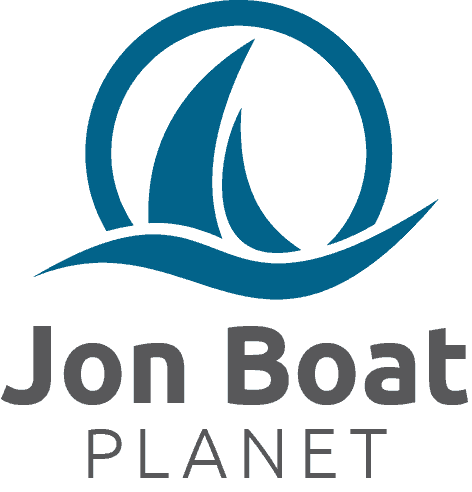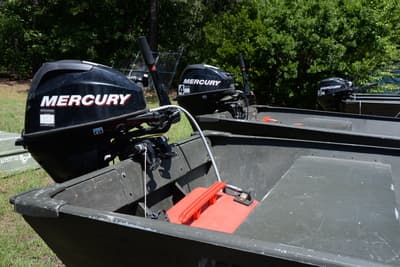
Jon Boats are incredibly versatile machines. Depending on the size of the boat, they can be your grandpa’s small pond dinghy with wooden oars, or fast-moving lake or river transport. You may or may not have a true need for speed based on your average usage. Nonetheless, we want to break down some averages based on our research.
Speed potential will be dictated by your boat size and thus max engine limitation, but here are some average speeds by boat length:
8 Foot: 5+ mph
10 Foot: 5-10 mph
12 Foot: 10-15 mph
14 Foot 20-25 mph
16 Foot: 25-30 mph
18-20 Foot: 35-45 mph
How in the world did we come up with this, you ask? We researched 30+ different boats and around 25 examples of their suitable engines and averaged out the results along with some extensive reading as to other boaters’ shared experiences. These averages will all have their exceptions, but generally speaking, they are a good starting point.
Why Boat Length Affects Speed
It might seem strange to look at the numbers above and think, “Why would adding two more feet of boat length get you 5-10 mph better performance? Wouldn’t smaller boats be faster?” And those would be very rational questions.
The reason boat length affects speed is because each boat length will have a manufacturer’s maximum recommended engine horsepower specific to that boat. Generally speaking, the bigger the boat, the more horsepower you can put in it.
While it would be a fun afternoon to drop a massive outboard on your nephew’s 8-footer, the reality is that it’s just too much power for a small vessel. Too much power for a given boat size leads to inherent instability and even dangerous handling qualities. It’s kind of like putting a 650hp engine in a ’68 Beetle. It’s just not built for that.
As you move up in boat lengths, you can start to put larger engines in them, and your speed potential increases. Granted, this will depend on how much weight you’re carrying (and how it’s distributed), but these are just averages to get you started. For reference, we also wrote an article on weight carrying capacities for various boat sizes as well.
Speeds by Boat Lengths
8 Foot Jon Boat Speed
Count on 5 mph, as these boats are very small to the point where you’re most likely looking at a small electric trolling motor for propulsion.
Sample Size:
It’s actually kind of tough to find many 8-footers, but we looked at a few such as the Sun Dolphin models and Field & Stream Angler series.
10 Foot Jon Boat Speed
Reasonably expect 5-10 mph for a 10-footer. At 10 feet in length, you’re generally looking at a 2.5-3.5hp outboard engine, with some models allowing for up to a 5hp engine. The 2.5-3.5hp will comfortably get you at least 5mph with whatever weight you’ve got in the boat, and the 5hp engine will get you more in the 10mph range.
Sample Size:
- Alumacraft 10 Foot Jon Boat: 3hp limit
- Lowe L1032 Jon: 3.5hp limit
- Waco Jon 1432 Series 10 Foot: 3hp limit
- Tracker Topper 1036: 3hp limit
- Smoker Craft 1032: 3hp limit
- G3 Boats 1036: 5hp limit
12 Foot Jon Boat Speed
10-15 mph is a good expectation for this boat size. This boat length will usually allow for a 5hp engine, with some models permitting up to 10hp engines. The 5hp engine will put you in the 10mph range, while the 7.50-10hp engines will push you 15+ mph.
Sample Size:
- Alumacraft 12 Foot Jon Boat: 7hp limit
- Lowe L1232: 3.5hp limit (this one is a little lower than our averages)
- Waco Jon 1432 Series 12 Foot: 5hp limit
- Tracker Topper 1236: 5hp limit
- Smoker Craft 1232: 6hp limit
- G3 Boats 1236: 10hp limit
- Pelican Intruder 12: 6hp limit
- Lost Creek 12 Foot: 5hp limit
14 Foot Jon Boat Speed
You can expect 20-25mph out of your 14-footer. This boat length will generally allow for a 15-20hp engine, with some permitting up to 25hp motors. What’s interesting about this boat length is that it is a considerable jump in horsepower (x2 or more) from just a two foot shorter 12 foot boat, according to our research and averages.
Sample Size:
- Waco Jon 1432 Series 14 Foot: 7hp limit
- Lowe L1436: 20hp limit
- Tracker Topper 1436: 15hp limit
- Smoker Craft 1436: 20hp limit
- G3 Boats 14 Foot (average of 14 foot models): 25hp limit
- Lost Creek 14 Foot: 15hp limit
16 Foot Jon Boat Speed
25-30mph can be expected at this boat size, which is driven by a 30-35hp engine on average. A 16-footer will also start to carry up to 4 people, so this speed will definitely depend on how much you’re carrying, as well as the arrangement of the weight itself.
Sample Size:
- Alumacraft 16 Foot Jon Boat: 35hp limit
- Lowe L1648: 35hp limit
- Tracker Grizzly 1648 Jon: 25hp limit
- Smoker Craft 1648: 35hp limit
- G3 Boats 16 Foot (average of 16 foot models): 25hp limit
- Crestliner 1600: 35hp limit
- XPress Boats 1650 VJ: 30hp limit
18 Foot Jon Boat Speed
35-45mph is realistic in a boat of this size. As mentioned previously, this is going to really start to depend on the weight of the boat, the conditions of the wind and water, and how you have the weight configured. 18-footers will allow up to around 60hp engines, which is nearly double the average motor size of a slightly shorter 16-foot Jon Boat.
Sample Size:
Note: For the 18 and 20 foot boat lengths, we intentionally kept this sample size on the smaller end. This is because boats of this size start to come more feature-packed and pre-configured, versus just being able to buy a hull and an engine separately. There are tons of boats out there for averages, but we wanted to keep the methodology consistent with the smaller boats.
- Tracker Grizzly 1860 Jon: 60hp limit
- Crestliner 1800: 40hp limit
- G3 Boats 16 Foot (average of 18 foot models): 60 hp limit
20 Foot Jon Boat Speed
35-45mph is realistic for a 20 Foot Jon Boat. You’ll notice this is the same speed we quoted for the 18 foot length, however the 20 foot models will allow for much larger engines and also carry more weight. Because of this added weight, you aren’t going to gain an astounding increase in speed, but you will be able to carry more and go just as fast. 20-footers have a max horsepower range of around 75-115. That’s a lot of horses for a little aluminum boat!
Sample Size:
Note: See note in 18 foot section about intentionally having a smaller sample size for the longer boat lengths.
- Lowe Roughneck 2070: 75hp limit
- Crestliner 2070 Retriever: 75hp limit
- G3 Boats Gator Tough (average of 20 foot models): 115hp limit
How Weight Distribution Affects Speed
Take two boats. They are identical in every way – the boat length, the engine model and size, the passengers, and the cargo. The only difference between boat #1 and boat #2 is that boat #1 has all of the passengers and cargo and weight in the rearward half (aft) of the boat, but boat #2 has the majority of the weight (except the engine and the captain) in the center of the boat.
Which will go faster?
All things equal, boat #2 will outperform boat #1 because of the way the boat is loaded. Boat #1 with the aft center of gravity (the center of all forces acting downward on the boat) causes the boat to angle upward or “tilt” the boat up. While this might help with initial acceleration, the boat may fail to ever plane or “level out” in cruise, meaning more of the boat is stuck in the water creating extra drag.
All of that to say, simply tweaking the weight distribution of your boat (usually towards the center) and ensuring that you can effectively plane out during cruise will make a huge impact on your top speed.
How Dirty Boats Affect Speed
Generally speaking, you want to limit the amount of buildup and external objects (algae, barnacles, etc.) you have on the bottom of your boat. Anything other than an extremely smooth (and clean) bottom surface just adds more drag to your boat and slows it down.
How fast do I need to go?
Since Jon Boats really aren’t going to enable water sports such as skiing, wakeboarding, or tubing (disclaimer: the larger boats can technically go fast enough to do this, but they really aren’t built for this), the question really becomes: how much distance do you need to cover?
If you’re navigating a lake and just need to go a few coves away on average, then cruising along at 15-20mph is going to be just fine and you don’t need to be racing around at 35+mph. If you’re routinely needing to cross a lake or move people or gear half an hour away, then that speed starts to become a lot more relevant.
What size is right for me?
While speed might be one of the requirements you have in your Jon Boat experience, of similar importance is going to be how much weight you need to carry. Just like speed, carrying capacity is really driven by the length and size of the boat. The bigger the boat, the more water it displaces (i.e. moves out of the way), and the more it can carry.
Quick science lesson: As long as the boat (and all that’s in it) weighs less than the weight of the water it displaces, it will float. This principle remains constant for Jon Boats all the way up to cruise ships.
We put together a post using the same research and data from above, but focused solely on weight capacity and carrying limits. You can read that post here.

